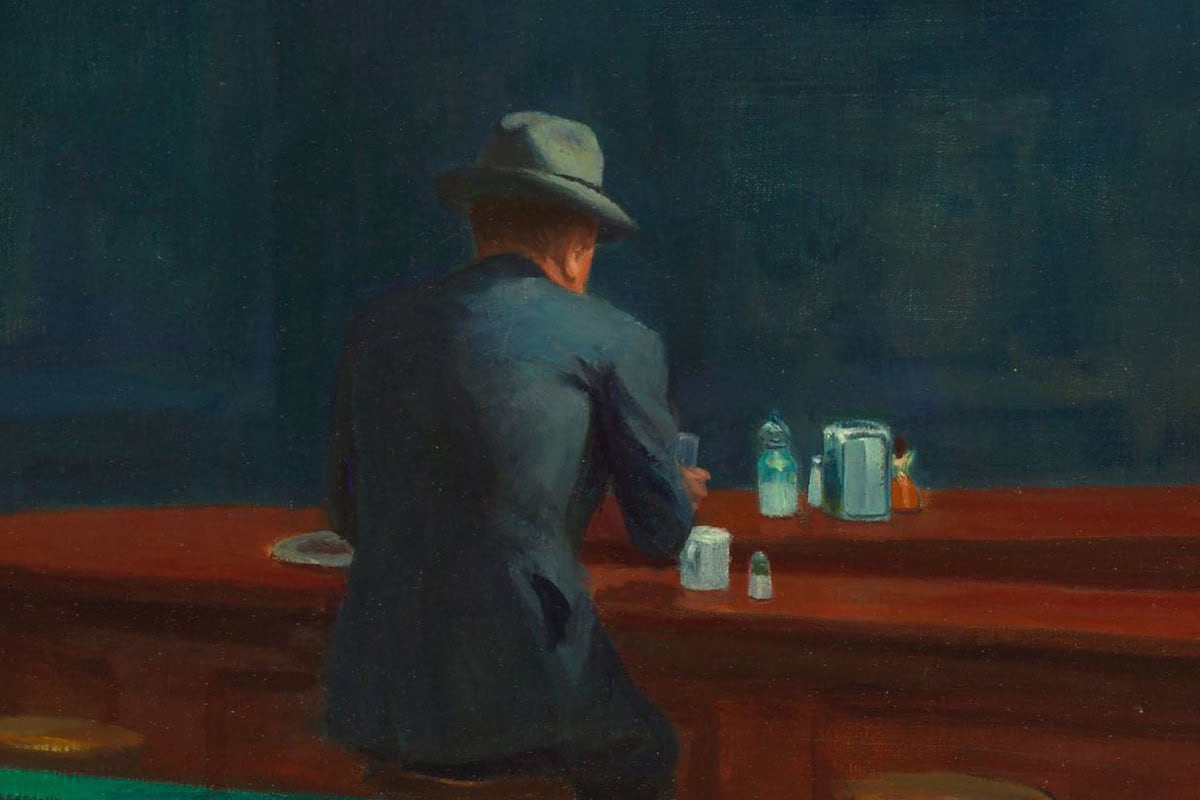Edward Hopper's Automat - A Haunting Depiction of Urban Alienation
At the height of the COVID-19 pandemic, social media platforms were inundated with countless depictions from art history that portrayed a dystopian world devoid of human presence. Among these artworks, the paintings of Edward Hopper garnered the most attention, owing to their intimate and frequently solitary depictions of individuals in private settings
It could be said the complete body of work by this prolific American painter revolves around the theme of urban estrangement brought on by modern lifestyles. Additionally, Hopper's imagery is inseprable from the broader context of popular culture, particularly the film noir genre that dominated American cinema in the 1940s and 1950s, characterized by elongated shadows, dramatic storylines, and a tired atmosphere.
The cinematic quality and evident suspense reached a pinnacle in numerous iconic paintings, among them Edward Hopper's Automat from 1927, which was exhibited for the first time on Valentine's Day of that year at the opening of the artist's second solo exhibition at the Rehn Galleries in New York City.

The Portrait of a Modern Woman
The painting features a portrait of a lone woman gazing at a cup of coffee in an automat at night. The wife of Edward Hopper, Jo, served as the model for the depicted figure. However, the artist altered her face to make her younger. The woman is well-dressed with makeup on, suggesting that she is having a cup of coffee after a job where personal appearance matters or having a coffee before attending a social occasion.
One of her gloves is removed, indicating a distraction, perhaps a hurry woman is in. While the season is apparent after the woman’s warm clothes, the time of day is unclear; it could be late at night, right after her working shift, or early in the morning before the shift is about to start. The restaurant seems empty, and there are no signs of activity inside or outside.
The chairback in the low right-hand corner of the painting suggests that the viewer is located at a nearby table. This fixation has another aspect since Hopper accentuated the woman's legs as the brightest spot in the painting, making her an object of desire.
It should be noted that during that period, only a select group of women were permitted to exercise the freedom of sitting alone in a bar. Even though the 1920s were characterized by a shift in societal attitudes towards women, the majority of the population still restricted the ways in which women could express themselves in a liberated manner. Across the US, women were expected to comply with the traditional role, except in urban environments such as New York, which offered greater job opportunities that could secure economic independence for those women willing to position themselves differently.

The Treatment Of The Venue
The interior depicted in this oil on canvas painting is reminiscent of an actual bar Automat in Times Square. However, it is Hopper’s interpretation of this venue. These bars, open at all hours of the day, were popular back in the 1920s; they were constantly frequented by thousands of customers. The artist based the depiction of each space on a scene unfolding as the viewer stares through a window. In some paintings, such as Railroad Sunset (1929), Nighthawks (1942), and Office in a Small City (1953), the details of the scene are seen beyond, although Hopper led the viewer's gaze through two panes of glass. Sometimes, he would obscure the view, and the window would be positioned at a sharp angle to the viewer's vantage point. Another favorite trick Hopper liked to use is the bright light spreading from the exterior at a sharp angle from the sun or an unseen streetlight, as seen in Conference at Night (1949).

Interpreting Edward Hopper's Automat
In 1927, the same year Hopper made Automat, the painting was sold for $1,200. Today it is part of the Des Moines Art Center collection in Iowa. Often compared with Édouard Manet's The Plum, Edgar Degas's L'Absinthe, or Edward Munch’s Melancholy, the atmosphere and subject matter of Automat is haunting and alludes to loneliness and, furthermore, urban alienation.
The previously mentioned concept describes the phenomenon developed at the peak of the industrial revolution and urbanization. The feeling of alienation is closely affiliated with social organization and labor, especially considering the context of American capitalism before the Great Depression. This particular interpretation of Edward Hopper’s Automat is still compelling, so it is not surprising this image was often used to illustrate numerous texts concerning stress and depression, for instance, a 1995 Time magazine article.
The artist was transfixed by modernization, the process he most definitely saw as challenging for the human soul. Whether alone or accompanied by family members, friends, and lovers, Hopper’s subjects pass through different emotional states in an attempt to articulate their existence.
The houses that seem deserted, darkened skyscrapers inhabited by estranged people in self-contained units, and gas stations in the middle of nowhere seem like sites populated by ghosts, even if they include actual human figures. This particular conclusion is enforced by the fact that Alfred Hitchcock was one of the painter’s biggest fans.
According to Hopper, modern life in the city can be extremely isolating and lonely. Despite changes in society, mental health issues continue to be overshadowed by the focus on consumerism and the constant production of goods. In today's world, which is marked by digital technology, the threat of nuclear war, and the possibility of more pandemics, Hopper's art serves as a poignant depiction of individuals feeling disconnected and struggling to make sense of the present.
Featured image: Edward Hopper - Automat, detail, 1927. the Des Moines Art Center collection, Iowa. Image via Gandalf's Gallery.
Can We Help?
Have a question or a technical issue? Want to learn more about our services to art dealers? Let us know and you'll hear from us within the next 24 hours.
